Papers by Hannah Peck

Behavioral Ecology, 2014
Resource competition is one potential behavioral mechanism by which invasive species can impact n... more Resource competition is one potential behavioral mechanism by which invasive species can impact native species, but detecting this competition can be difficult due to the interactions that variable environmental conditions can have on species behavior. This is particularly the case in urban habitats where the disturbed environment can alter natural behavior from that in undisturbed habitats. The rose-ringed parakeet (Psittacula krameri), is an increasingly common invasive species, predominantly associated with large urban centers. Using an experimental approach, we tested the behavioral responses of native garden birds in response to the presence of a rose-ringed parakeet versus the presence of a similarly sized and dominant native bird, the great spotted woodpecker (Dendrocopos major). Parakeet presence significantly reduced feeding rates and increased vigilance among native birds compared with our control treatments. Of visits made by native birds in the presence of a parakeet, feeding was more likely to occur in sites within the parakeet range compared with sites outside, suggesting some habituation of native birds has occurred following prior exposure to parakeets but overall foraging behavior is still disrupted. The results of our study suggest that nonnative species can have complex and subtle impacts on native fauna and show that a nonnative competitor can impact native species simply through their presence near resources.

European Journal of Wildlife Research, 2014
The ring-necked parakeet (RNP), (Psittacula krameri), is an invasive species in Great Britain (GB... more The ring-necked parakeet (RNP), (Psittacula krameri), is an invasive species in Great Britain (GB) which is undergoing rapid population expansion in the wild. Although it has been suggested that RNPs could be a potential source of infectious disease, little research has been done on the pathogens infecting this species in GB. Psittacine beak and feather disease (PBFD), caused by beak and feather disease virus (BFDV), is an important infectious disease of psittacines, including captive RNPs, in GB and elsewhere. A wild RNP with marked feather abnormalities observed in an urban garden in London was euthanased and examined post mortem. Plucked contour feathers and pooled liver and spleen were PCR positive for BFDV DNA. Histopathological examination of affected skin demonstrated BFDV-compatible lesions. A feather from another RNP from a different location also was PCR-positive for BFDV. This is the first report of PBFD in a wild free living bird in GB. BFDV only affects psittacines; therefore, there is no known risk to native British birds. The presence of BFDV in free-living RNPs, however, could pose a disease threat to captive psittacines. Further work is required to determine the distribution and impact of BFDV infection in free-living RNPs in GB. Whether this case represents sporadic disease associated with established endemic infection, or the index case of an emergent disease is currently unknown.
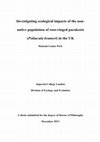
The rose-ringed parakeet has been present in the South East of England since at least the 1970s. ... more The rose-ringed parakeet has been present in the South East of England since at least the 1970s. However, there is little understanding about the impact that this exotic, gregarious bird has on native wildlife and therefore whether anything should or can be done to restrict potential impacts. The aim of this thesis is to provide an updated census of South East England's parakeet population size and growth, and investigate any evidence of ecological impacts to help inform policy makers making decisions on mitigation strategies for the rose-ringed parakeet. This has been achieved through using roost counts to regularly survey the population over three years and by carrying out two garden feeding experiments to look at effects of parakeet presence on bird feeding behaviour and on competition for food. I show that the rose-ringed parakeet population is well established in the UK, with over 30,000 individuals, has undergone rapid growth since 1996 but that the core London population appears to have reached capacity. I also show evidence of competition for food between parakeets and native birds, causing negative impacts on native bird foraging behaviour and resulting in a reduction in garden bird species accessing food. The overall findings of this research are that parakeets have the potential to reach high numbers in urban areas and that they do compete for food with native birds, but as yet there is no evidence for population level effects on native species. This adds to the knowledge of ecological impacts of the rose-ringed parakeet and provides further insight into the behavioural impacts that non-native species can have on native wildlife. I discuss the implications of these findings for future management and policy.
Trends in Plant Science, 2014
European Journal of Wildlife Research, 2014
The ring-necked parakeet (RNP), Psittacula krameri, is an invasive species in Great Britain (GB) ... more The ring-necked parakeet (RNP), Psittacula krameri, is an invasive species in Great Britain (GB) which is undergoing rapid population expansion in the wild.
Trends in Plant Science, 2014

Behavioral Ecology, 2014
Resource competition is one potential behavioral mechanism by which invasive species can impact n... more Resource competition is one potential behavioral mechanism by which invasive species can impact native species, but detecting this competition can be difficult due to the interactions that variable environmental conditions can have on species behavior. This is particularly the case in urban habitats where the disturbed environment can alter natural behavior from that in undisturbed habitats. The rose-ringed parakeet (Psittacula krameri), is an increasingly common invasive species, predominantly associated with large urban centers. Using an experimental approach, we tested the behavioral responses of native garden birds in response to the presence of a rose-ringed parakeet versus the presence of a similarly sized and dominant native bird, the great spotted woodpecker (Dendrocopos major). Parakeet presence significantly reduced feeding rates and increased vigilance among native birds compared with our control treatments. Of visits made by native birds in the presence of a parakeet, feeding was more likely to occur in sites within the parakeet range compared with sites outside, suggesting some habituation of native birds has occurred following prior exposure to parakeets but overall foraging behavior is still disrupted. The results of our study suggest that nonnative species can have complex and subtle impacts on native fauna and show that a nonnative competitor can impact native species simply through their presence near resources.
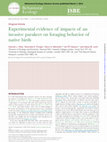
Behavioral Ecology, 2014
Resource competition is one potential behavioral mechanism by which invasive species can impact n... more Resource competition is one potential behavioral mechanism by which invasive species can impact native species, but detecting this competition can be difficult due to the interactions that variable environmental conditions can have on species behavior. This is particularly the case in urban habitats where the disturbed environment can alter natural behavior from that in undisturbed habitats. The rose-ringed parakeet (Psittacula krameri), is an increasingly common invasive species, predominantly associated with large urban centers. Using an experimental approach, we tested the behavioral responses of native garden birds in response to the presence of a rose-ringed parakeet versus the presence of a similarly sized and dominant native bird, the great spotted woodpecker (Dendrocopos major). Parakeet presence significantly reduced feeding rates and increased vigilance among native birds compared with our control treatments. Of visits made by native birds in the presence of a parakeet, feeding was more likely to occur in sites within the parakeet range compared with sites outside, suggesting some habituation of native birds has occurred following prior exposure to parakeets but overall foraging behavior is still disrupted. The results of our study suggest that nonnative species can have complex and subtle impacts on native fauna and show that a nonnative competitor can impact native species simply through their presence near resources.
Junior scientists are skeptical of skeptics of open access: A reply to Agrawal., Jun 2014
Anurag A. Agrawal [1] recently published a letter in TIPS in which he suggested four points that ... more Anurag A. Agrawal [1] recently published a letter in TIPS in which he suggested four points that researchers should consider when choosing to publish open access (OA). Although a critical evaluation of the pros and cons of publishing OA are warranted and important, three other points should also be considered when discussing OA.

Resource competition is one potential behavioral mechanism by which invasive species can impact n... more Resource competition is one potential behavioral mechanism by which invasive species can impact native species, but detecting this competition can be difficult due to the interactions that variable environmental conditions can have on species behavior. This is particularly the case in urban habitats where the disturbed environment can alter natural behavior from that in undisturbed habitats. The rose-ringed parakeet (Psittacula krameri), is an increasingly common invasive species, predominantly associated with large urban centers. Using an experimental approach, we tested the behavioral responses of native garden birds in response to the presence of a rose-ringed parakeet versus the presence of a similarly sized and dominant native bird, the great spotted woodpecker (Dendrocopos major). Parakeet presence significantly reduced feeding rates and increased vigilance among native birds compared with our control treatments. Of visits made by native birds in the presence of a parakeet, feeding was more likely to occur in sites within the parakeet range compared with sites outside, suggesting some habituation of native birds has occurred following prior exposure to parakeets but overall foraging behavior is still disrupted. The results of our study suggest that nonnative species can have complex and subtle impacts on native fauna and show that a nonnative competitor can impact native species simply through their presence near resources.

The ring-necked parakeet (RNP), Psittacula krameri, is an invasive species in Great Britain (GB) ... more The ring-necked parakeet (RNP), Psittacula krameri, is an invasive species in Great Britain (GB) which is undergoing rapid population expansion in the wild. Although it has been suggested that RNPs could be a potential source of infectious disease, little research has been done on the pathogens infecting this species in GB. Psittacine beak and feather disease (PBFD), caused by beak and feather disease virus (BFDV), is an important infectious disease of psittacines, including captive RNPs, in GB and elsewhere. A wild RNP with marked feather abnormalities observed in an urban garden in London was euthanased and examined post mortem. Plucked contour feathers and pooled liver and spleen were PCR-positive for BFDV DNA. Histopathological examination of affected skin demonstrated BFDV-compatible lesions. A feather from another RNP from a different location also was PCR-positive for BFDV. This is the first report of PBFD in a wild free-living bird in GB. BFDV only affects psittacines; therefore, there is no known risk to native British birds. The presence of BFDV in free-living RNPs, however, could pose a disease threat to captive psittacines. Further work is required to determine the distribution and impact of BFDV infection in free-living RNPs in GB. Whether this case represents sporadic disease associated with established endemic infection or the index case of an emergent disease is currently unknown.
Talks by Hannah Peck
The invasive rose-ringed parakeet has been established in the UK for over 40 years. We provide ev... more The invasive rose-ringed parakeet has been established in the UK for over 40 years. We provide evidence that whilst the UK’s population has exploded over the last 10 years, the London population appears to be reaching its capacity. We examine the population dynamics of this exotic bird, and explore the implications of these findings for management of this globally expanding species.
Populations of rose-ringed parakeets (Psittacula krameri) have been rapidly increasing in cities ... more Populations of rose-ringed parakeets (Psittacula krameri) have been rapidly increasing in cities across Europe, yet little is known about the impacts of this invasive bird on native species' behaviour. Using an experimental design carried out at bird feeding stations, we have tested whether rose-ringed parakeets compete indirectly for food resources with native bird species and found parakeet presence reduced both the number and duration of feeding visits. This demonstrates that native birds' foraging behaviour is negatively impacted by parakeet presence, the potential consequences of which are highlighted by the increasing growth of invasive parakeet populations.
The UK's parakeet population has reached over 31,000 but little is known about their impacts on n... more The UK's parakeet population has reached over 31,000 but little is known about their impacts on native fauna. Using an experimental design carried out at bird feeding stations across London, I have tested whether rose-ringed parakeets (Psittacula krameri) compete indirectly for food resources with native bird species. Parakeet presence had a negative effect on native bird foraging behaviour; with both number of feeding visits and duration being reduced and more so than compared to the presence of a dominant native species (Dendropcopus major). The potential impacts of this are highlighted by the rapid growth of the population in SE England.
Using an experimental design carried out at bird feeding stations across London, I have tested wh... more Using an experimental design carried out at bird feeding stations across London, I have tested whether rose-ringed parakeet (Psittacula krameri) compete indirectly for food resources with native bird species. I found that parakeet presence at feeding stations has a negative effect on native bird feeding behaviour; with both number of feeding visits and feeding duration being reduced. The potential impacts of this is highlighted by the rapid growth of the population at 23% over the past 15years estimated by using simultaneous roost counts across the South East of the UK concluding that the population has reached over 30,000.
Thesis Chapters by Hannah Peck
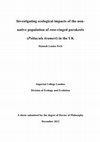
The rose-ringed parakeet has been present in the South East of England since at least the 1970s. ... more The rose-ringed parakeet has been present in the South East of England since at least the 1970s. However, there is little understanding about the impact that this exotic, gregarious bird has on native wildlife and therefore whether anything should or can be done to restrict potential impacts.
The aim of this thesis is to provide an updated census of South East England’s parakeet population size and growth, and investigate any evidence of ecological impacts to help inform policy makers making decisions on mitigation strategies for the rose-ringed parakeet. This has been achieved through using roost counts to regularly survey the population over three years and by carrying out two garden feeding experiments to look at effects of parakeet presence on bird feeding behaviour and on competition for food. I show that the rose-ringed parakeet population is well established in the UK, with over 30,000 individuals, has undergone rapid growth since 1996 but that the core London population appears to have reached capacity. I also show evidence of competition for food between parakeets and native birds, causing negative impacts on native bird foraging behaviour and resulting in a reduction in garden bird species accessing food. The overall findings of this research are that parakeets have the potential to reach high numbers in urban areas and that they do compete for food with native birds, but as yet there is no evidence for population level effects
on native species. This adds to the knowledge of ecological impacts of the rose-ringed parakeet and provides further insight into the behavioural impacts that non-native species can have on native wildlife. I discuss the implications of these findings for future management and policy.









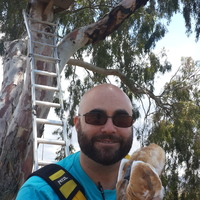
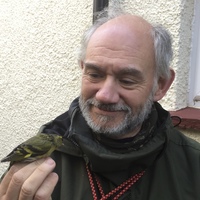
Uploads
Papers by Hannah Peck
Talks by Hannah Peck
Thesis Chapters by Hannah Peck
The aim of this thesis is to provide an updated census of South East England’s parakeet population size and growth, and investigate any evidence of ecological impacts to help inform policy makers making decisions on mitigation strategies for the rose-ringed parakeet. This has been achieved through using roost counts to regularly survey the population over three years and by carrying out two garden feeding experiments to look at effects of parakeet presence on bird feeding behaviour and on competition for food. I show that the rose-ringed parakeet population is well established in the UK, with over 30,000 individuals, has undergone rapid growth since 1996 but that the core London population appears to have reached capacity. I also show evidence of competition for food between parakeets and native birds, causing negative impacts on native bird foraging behaviour and resulting in a reduction in garden bird species accessing food. The overall findings of this research are that parakeets have the potential to reach high numbers in urban areas and that they do compete for food with native birds, but as yet there is no evidence for population level effects
on native species. This adds to the knowledge of ecological impacts of the rose-ringed parakeet and provides further insight into the behavioural impacts that non-native species can have on native wildlife. I discuss the implications of these findings for future management and policy.
The aim of this thesis is to provide an updated census of South East England’s parakeet population size and growth, and investigate any evidence of ecological impacts to help inform policy makers making decisions on mitigation strategies for the rose-ringed parakeet. This has been achieved through using roost counts to regularly survey the population over three years and by carrying out two garden feeding experiments to look at effects of parakeet presence on bird feeding behaviour and on competition for food. I show that the rose-ringed parakeet population is well established in the UK, with over 30,000 individuals, has undergone rapid growth since 1996 but that the core London population appears to have reached capacity. I also show evidence of competition for food between parakeets and native birds, causing negative impacts on native bird foraging behaviour and resulting in a reduction in garden bird species accessing food. The overall findings of this research are that parakeets have the potential to reach high numbers in urban areas and that they do compete for food with native birds, but as yet there is no evidence for population level effects
on native species. This adds to the knowledge of ecological impacts of the rose-ringed parakeet and provides further insight into the behavioural impacts that non-native species can have on native wildlife. I discuss the implications of these findings for future management and policy.